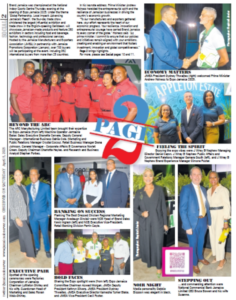
That uncertain business of weather predictions
In late September 1963, Hurricane Flora, among the most destructive Atlantic storms ever, entered the Caribbean basin on a path very similar to the recent Hurricane Matthew.
Just like Matthew, Flora passed through the islands of the south-eastern Caribbean. But unlike Matthew, which drifted a considerable distance into the central Caribbean before making a drastic turn to the north, Flora took a more gradual northerly turn shortly after entering the Caribbean basin.
While it was clear from early that Flora was likely to have its greatest impact on Haiti, Jamaicans were warned to expect the worst.
Just as well. Flora eventually crossed Haiti’s western peninsula and into eastern Cuba on a path strikingly similar to Matthew, but the 1963 storm also caused extensive destruction in Jamaica, and took 11 lives here.
All told, Flora — immortalised in the Jamaican memory as the Flora rains — caused thousands of deaths in the Caribbean, mostly in Haiti, but also in eastern Cuba, The Bahamas and Jamaica. Much of the grief and destruction here resulted from flooding. Older Jamaicans recall that it rained for days. And the records suggest that, at that time, the extent of flooding in eastern parts of the island was close to being unprecedented in living memory.
Intriguingly, for reasons weather experts are better able to explain, though the eye of Matthew may have been even closer to Jamaica than was Flora’s, the effect on this country of the recent storm — said to have been one of the strongest to affect the Caribbean — was quite minimal.
By contrast, there were destructive consequences to the east of Matthew’s eye with extensive flooding as far away as the Dominican Republic. Of course, the bulk of Matthew’s ferocity was centred on western Haiti, on or around the eye of the storm, causing close to 1,000 deaths; as well as eastern Cuba, The Bahamas and the US south-eastern coastline.
We have said all of the above to make the simple point that weather forecasting is an inexact business. It seems clear, that even with the assistance of today’s highly advanced technology, meteorologists cannot say with absolute certainty what will happen with the weather – though they often sound as if they are doing exactly that.
Yet, they must warn in the clearest, starkest terms of the potential dangers, so that people can prepare for the worst. With that there can be no compromise.
The trouble is that when not much happens, as was the Jamaican experience of Hurricane Matthew, a ‘cry wolf’ mentality can set in, with segments of the population ignoring future warnings. As former parliamentarian Lloyd B Smith recently pointed out, such a scenario could have disastrous consequences.
To some extent weather experts are damned if they do and damned if they don’t. Let’s not forget that as recently as the Nicole rains of 2010, they were criticised on the basis of popular perception of inadequate pro-activity in alerting people.
It seems to us, though, that weather experts could help their own credibility by making it abundantly clear, even as they make predictions and paint worst-case pictures, that their science is not exact. In other words: that they could be wrong.
For starters, they could use that approach in their regular daily reports on radio and television.
























